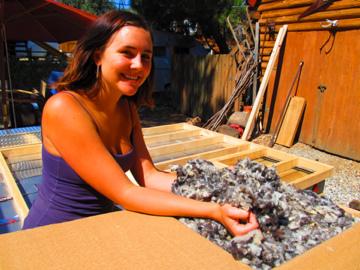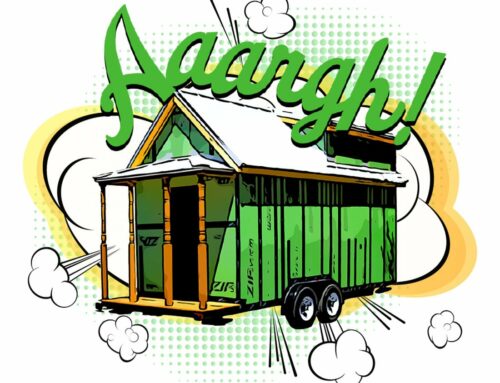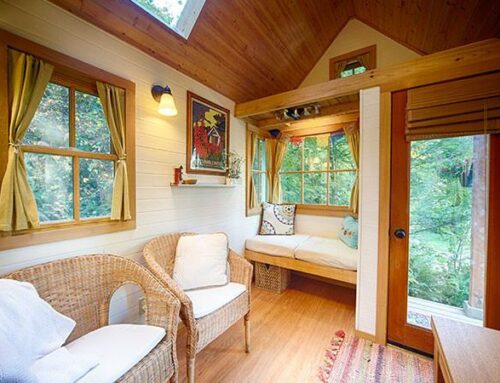What makes a tiny house a home? Proper insulation, to keep you toasty in the winter and cooler in the summer. Insulation creates energy efficiency as well as helps control temperatures in your home. In a tiny house on wheels, there’s insulation in the trailer, walls and roof.
Whenever you are building a home, whether it be a tiny home or a mansion, you have the option to choose greener materials. This choice depends on your own personal preference, but it is an important factor to weigh if you intend on installing the insulation yourself. Some insulations contain harmful fibers and will require a respirator when installing, such as fiberglass insulation.
Over the years we used rigid foam board, spray foam insulation, and sheep wool. We finally settled on Rock Wool because of the minimal environmental impact and ease of installing it.
Spray Foam:
In the past we used polyurethane spray foam; a high density closed-cell foam which seals tight the walls and roof. On the plus side, it provided R-20 insulation factor exceeding that of any RV and many normal residential homes. Installing this foam is a pricey proposition and requires some expertise.
Fiberglass:
You do have insulation choices beyond spray foam. Fiberglass batts are most commonly used by tiny house builders and, with sufficient thickness, provide excellent insulation. While fiberglass may feel scratchy and irritate installers, there aren’t issues after it gets enclosed within walls.
EPS:
The most popular trailer insulation is EPS (extruded polystyrene), a foam closed-cell structure with consistent skin. We install three inches of rigid foam board is used in the trailer, and the cover that with a vapor barrier that adds another 3R.
SIPs:
New SIP (structural insulated panel) walls and roofs are another approach. Rather than using stick construction, you measure and order pre-cut panels which include foam insulation encased by OSB (oriented strand board). Many DIY tiny house builders go this route. It’s expensive but provides fantastic quality.
Sheep Wool:
Of course, sheep wool works well for clothing. It’s also an organic material that gets used for housing insulation, though often gets treated with borax (from mining) as a fire retardant and insect/pest repellent. See wool batts installed at Wool Shepard Insulation.
Stone Wool:
This insulation is made from volcanic diabase rock, that’s crushed, mixed with coke and slags, then melted in a furnace. Afterwards it resembles wool in its appearance. This insulation claims to prevent rot or vermin problems. Please check out Roxul batts.
Cellulose:
Wet spray cellulose, made from newspapers, has similar insulation factors to sheep and stone wool. It requires a high-power blower to install correctly, and then needs to dry out. With a difficult (to get right) process, we don’t recommend it for tiny house builders.
Blue Jeans:
Last and definitely not least, consider blue jeans as an alternative insulation material. Denim insulation is recycled from textile fibers and there are no chemical irritants either. To see an example, check out Ultra Touch here.
Tiny House Giant Journey‘s Rigid Foam Board Insulation












Hey! This write-up is super helpful. Thank you for sharing this info. I like that you have mentioned the option of choosing greener materials. I am always interested in things that help protect the environment. Can you suggest material for the most environmentally friendly insulation? You said cellulose needs a high-power blower for correct installation and drying out. Is this a type of insulation that takes the longest to be completed?